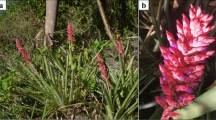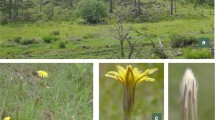Abstract
Haberlea is one of the few Gesneriaceae genera that has entered Europe. It is a highly endangered genus and red-listed in Bulgaria. Two species, H. rhodopensis and H. ferdinandi-coburgii, have been described to occur in Bulgaria, but this has never been addressed systematically. Here, we used molecular ISSR markers, morphological and nuclear DNA content to investigate the taxonomic and genetic status of Haberlea in Bulgaria. We found low levels of genetic diversity but significant genetic differentiation among the 12 investigated populations, with a strong separation between Balkan Mountain populations in the north and Rhodope Mountain populations in the south. However, the multivariate morphological analyses did not support such a division. The population from near Lovech, the type locality of the putative species H. ferdinandi-coburgii, did not differ in ploidy level from H. rhodopensis and did not form a separate entity in neither of the analyses and the existence of this species is therefore not supported.




Similar content being viewed by others
References
Adamović L (1903) On Urumoff’s Haberlea ferdinandi-coburgii. Bot Centralbl 92(24):207
Archibald JK, Mort ME, Crawford DJ, Santos-Guerra A (2006) Evolutionary relationships within recently radiated taxa: comments on methodology and analysis of inter-simple sequence repeat data and other hypervariable, dominant markers. Taxon 55:747–756
Avise JC (2000) Phylogeography: the history and formation of species. Harvard University Press, Cambridge
Bazos I, Petrova A (2010) Haberlea rhodopensis. In: IUCN 2011 IUCN red list of threatened species, version 2011.1
Beaufort-Murphy HT (1983) The seed surface morphology of the Gesneriaceae utilizing the scanning electron microscope and a new system for diagnosing seed morphology. Selbyana 6:220–422
Biodiversity Law (2002) Decree N283 accepted by the National Assembly. Darzhaven Vestnik, N77/09.08.2002:9–42 (in Bulgarian)
Biserkov V (2011) Red data book of the Republic of Bulgaria, vol 3. Natural habitats. Joint edition of the Bulgarian Academy of Sciences and Ministry of Environment and Water http://e-ecodb.bas.bg/rdb/en/vol3/
Borhidi A (1968) Karyological studies on southeast European plant species, I. Acta Botanica Academiae Scientarium Hungaricae 14:253–260
Burtt BL (1977) Classification above the genus, as exemplified by Gesneriaceae, with parallels from other groups. Pl Syst Evol Suppl 1:97–109
Burtt BL (1997) Old World Gesneriaceae: V. Suprageneric names. Edinb J Bot 54:85–90
Camacho FJ, Liston A (2001) Population structure and genetic diversity of Botrychium pumicola (Ophioglossaceae) based on inter-simple sequence repeats (ISSR). Amer J Bot 88:1065–1070
Casgrain P, Legendre P, Vaudor A (2005) The Royal package for multivariate and spatial analysis, Version 4.0 (development release 10)
Cattell RB (1966) The scree test for the number of factors. Multivar Behav Res 1:245–276
Clark PU, Dyke AS, Shakun JD, Carlson AE, Clark J, Wohlfarth B, Mitrovica JX, Hostetler SW, McCabe AM (2009) The last glacial maximum. Science 325:710–714
Contandriopoulos J (1966) Contribution á l’étude caryologiques des Gesnériacées d’Europe et de leur germination. 91 Congrès des Sociétés Savantes. Rennes 3:271–280
Costich DE, Ortiz R, Meagher RT, Bruederle LP, Vorsa N (1993) Determination of ploidy level and nuclear DNA content in blueberry by flow cytometry. Theor Appl Genet 86:1001–1006
Dellaporta SL, Wood J, Hicks JB (1983) A plant DNA mini-preparation: version II. Plant Mol Biol Rep 1:19–21
Doležel J, Bartoš J (2005) Plant DNA flow cytometry and estimation of nuclear genome size. Ann Bot 95:99–110
Dubreuil M, Riba M, Mayol M (2008) Genetic structure and diversity in Ramonda myconi (Gesneriaceae): effects of historical climate change on a preglacial relict species. Amer J Bot 95:577–587
Eckert JE (1933) The flight range of the honeybee. J Agricult Res 47:257–285
Excoffier L, Smouse PE, Quattro JM (1992) Analysis of molecular variance inferred from metric distances among DNA haplotypes: application to human mitochondrial DNA restriction data. Genetics 131:479–491
Fang DQ, Roose ML (1997) Identification of closely related citrus cultivars with inter-simple sequence repeat genetics. Theor Appl Genet 95:408–417
Frivaldszky I (1835) Közlések a’ Balkány’ vidékén tett természettudományi utazásról. Magyar Tud Társ Évk 2:235–276
Ganchev I (1950) Anabiotic desiccation resistance and other biological traits of Haberlea rhodopensis Friv. Rep Inst Bot Bulg Acad Sci 1(1):191–214
Gao LM, Möller M, Zhang XM, Hollingsworth ML, Liu J, Mill RR, Gibby M, Li DZ (2007) High variation and strong phylogeographic pattern among cpDNA haplotypes in Taxus wallichiana (Taxaceae) in China and North Vietnam. Mol Ecol 16:4684–4698
Greilhuber J (2005) Intraspecific variation in genome size in angiosperms: identifying its existence. Ann Bot 95:91–98
Hamrick JL, Godt MJW (1989) Allozyme diversity in plant species. In: Brown ADH, Clegg MT, Kahler AL, Weir BS (eds) Plant population genetics, breeding, and genetic resources. Sinauer, Sunderland, pp 43–63
Hogbin PM, Peakall R (1999) Evaluation of the contribution of genetic research to the management of the endangered plant Zieria prostrata. Conserv Biol 13:514–522
Huff DR, Peakall R, Smouse PE (1993) RAPD variation within and among natural populations of outcrossing buffalograss. Theor Appl Genet 86:927–934
Jaccard P (1908) Nouvelles recherches sur la distribution florale. Bull Soc Vaud Sci Nat 44:223–270
Kiani M, Memariani F, Zarghami H (2012) Molecular analysis of species of Tulipa L. from Iran based on ISSR markers. Plant Syst Evol 298:1515–1522
Leitch I, Bennett M (1997) Polyploidy in angiosperms. Trends Plant Sci 2:470–476
Lepper L (1970) Beiträge zur Chromosomenzahlen-Dokumentation. Wissenschaftliche Zeitschrift Friedrich-Schiller-Universität Jena/Thüringen. Mathematisch-naturwissenschaftliche Reihe 19:369–376
Markova M (1995) Semeistvo CXX. Silivryakovi–Gesneriaceae Dum. [Gesneria family—Gesneriaceae Dum.]. In: Kozhuharov S (ed) Flora Reipubl. Bulgaricae, Editio Acad. “Prof. Marin Drinov”, Serdicae. pp 288–291
Milne C (1975) Chromosome numbers in the Gesneriaceae: V. Notes Roy. Bot Gard Edinb 33:523–525
Möller M, Gao LM, Mill RR, Li DZ, Hollingsworth ML, Gibby M (2007) Morphometric analysis of the Taxus wallichiana complex (Taxaceae) based on herbarium material. Bot J Lin Soc 155(3):307–335
Munthali M, Ford-Lloyd BV, Newbury HJ (1992) The random amplification of polymorphic DNA for fingerprinting plants. PCR Meth Applic 1:274–276
Nei M (1972) Genetic distance between populations. Amer Nat 106:283–392
Obermayer R, Leitch IL, Hanson L, Bennett M (2002) Nuclear DNA C-values in 30 species double the familial representation in pteridophytes. Ann Bot 90:209–217
Peakall R, Smouse PE (2006) GenAlEx 6: genetic analysis in Excel. Population genetic software for teaching and research. Mol Ecol Notes 6:288–295
Peakall R, Smouse PE (2012) GenAlEx 6.5: genetic analysis in Excel. Population genetic software for teaching and research—an update. Bioinformatics doi:10.1093/bioinformatics/bts460
Petrova A (2006) Atlas of Bulgarian endemic plants. Gea-Libris Publishing House, Sofia
Petrova A, Vladimirov V (2010) Balkan endemics in the Bulgarian flora. Phytol Balcan 16:293–311
Petrova G, Tosheva A, Mladenov P, Moyankova D, Djilianov D (2010) Ex situ collection of model resurrection plant Haberlea rhodopensis as a prerequisite for a biodiversity and conservation studies. Biotechnol & Biotechnol Eq 24:1955–1959
Ratnieks FLW (2000) How far do bees forage. Bee Improv 6:10–11
Siljak-Yakovlev S, Stevanovic V, Tomasevic M, Brown SC, Stevanovic B (2008) Genome size variation and polyploidy in the resurrection plant genus Ramonda: cytogeography of living fossils. Environm Exp Bot 62:101–112
Sneath PHA, Sokal RR (1973) Numerical taxonomy—the principles and practice of numerical classification. WH Freeman, San Francisco
Strid A (1991) Haberlea rhodopensis Friv. In: Strid A, Tan K (eds) Mountain flora of Greece, vol 2. Edinburgh University Press, Edinburgh, p 260
Swofford DL (2002) PAUP*: phylogenetic analysis using parsimony (*and other methods), version 4. Sinauer Associates, Sunderland
Szeląg Z, Somlyay L (2009) History of typification of Haberlea rhodopensis Friv. (Gesneriaceae). Ann Bot Fenn 46:555–558
Thompson JD (2005) Plant evolution in the Mediterranean. Oxford University Press, New York
Turrill WB (1951) Some problems of plant range and distribution. J Ecol 39:205–227
Urumoff IK (1902) Plantae novae bulgaricae. Period Spis Bulg Knizh Druzh 63:573
Vassilev P (1984) Haberlea rhodopensis Friv. In: Velchev V (ed) Red data book of the PR Bulgaria, vol 1. 349, Plants. Publishing House Bulgarian Academy of Sciences, Sofia
Voglmayr H (2000) Nuclear DNA amounts in mosses (Musci). Ann Bot 85:531–546
Vokou D, Petandiou Th, Bellos D (1990) Pollination ecology and reproductive potential of Jancaea heldreichii (Gesneriaceae); a tertiary relict on Mt Olympus, Greece. Biol Cons 52:125–133
Vos P, Hogers R, Bleeker M, Reijans M, Lee TV, Hornes M, Frijters A, Pot J, Peleman J, Kuiper M, Zabeau M (1995) AFLP: a new technique for DNA fingerprinting. Nucl Acids Res 23:4407–4414
Walter KS, Gillet HJ (1998) Red list of threatened plants compiled by the World Conservation Monitoring Centre, IUCN. The World Conservation Union, Gland, Switzerland and Cambridge, UK
Weber A (2004) Gesneriaceae. In: Kubitzki K, Kadereit JW (ed) The families and genera of vascular plants, Dicotyledons. Lamiales (except Acanthaceae incl. Avicenniaceae), vol 7. Springer, Berlin, pp 63–158
Weber A, Skog LE (2007) The genera of Gesneriaceae. Basic information with illustration of selected species. http://www.generagesneriaceae.at
Wolfe AD, Liston A (1998) Contributions of PCR-based methods to plant systematics and evolutionary biology. In: Soltis PS, Soltis DE, Doyle JJ (eds) Molecular systematics of plants: DNA sequencing. Kluwer, New York, pp 43–86
Wolfe AD, Randle CP (2001) Relationships within and among species of the holoparasitic genus Hyobanche (Orobanchaceae) inferred from ISSR banding patterns and nucleotide sequences. Syst Bot 26:120–130
Xiao LQ, Gong X (2006) Genetic differentiation and relationship of populations in Cycas balansae complex (Cycadaceae) and its conservation implications. Ann Bot 97:807–812
Zietkiewicz E, Rafalski A, Labuda D (1994) Genome fingerprinting by simple sequence repeats (SSR)-anchored PCR amplifications. Genomics 20:176–183
Acknowledgments
We like to thank Petko Mladenov from the Abiotic Stress Group (ABI), and Dr. Anita Tosheva, Department of Botany, Faculty of Biology, Sofia University, for support in the collection of study material. We like to thank the European Commission for a FPVI European-funded Integrated Infrastructure Initiative SYNTHESYS grant to DM (GB-TAF-4741). The Royal Botanic Garden Edinburgh (RBGE) is supported by the Rural and Environment Science and Analytical Services division (RESAS) in the Scottish Government.
Author information
Authors and Affiliations
Corresponding authors
Additional information
G. Petrova and M. Möller contributed equally to the work and should be considered first authors.
Electronic supplementary material
Below is the link to the electronic supplementary material.
Rights and permissions
About this article
Cite this article
Petrova, G., Dzhambazova, T., Moyankova, D. et al. Morphological variation, genetic diversity and genome size of critically endangered Haberlea (Gesneriaceae) populations in Bulgaria do not support the recognition of two different species. Plant Syst Evol 300, 29–41 (2014). https://doi.org/10.1007/s00606-013-0857-z
Received:
Accepted:
Published:
Issue Date:
DOI: https://doi.org/10.1007/s00606-013-0857-z




